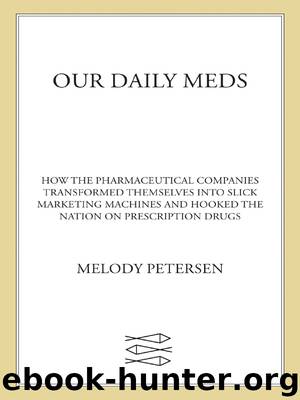Our Daily Meds by Melody Petersen

Author:Melody Petersen
Language: eng
Format: mobi, epub
Publisher: Farrar, Straus and Giroux
Published: 2008-07-28T21:00:00+00:00
AT THE TIME the executives were planning their sales strategy for the epilepsy drug, Warner-Lambert was one of the nation’s fastest-growing companies. Few Americans would have recognized the name Neurontin, or Warner-Lambert for that matter. They were more likely to know the company’s nonmedicinal products, which included Bubblicious chewing gum, Schick razors, and Listerine.
It was not the candy or mouthwash that was making Warner-Lambert rich, however. Most of its profits came from Parke-Davis, the subsidiary selling prescription drugs. Parke-Davis had once been an independent company that had grown to be the world’s largest drug manufacturer. It was founded in the 1860s, when H. C. Parke and George S. Davis took over a pharmacy in Detroit, Michigan, and expanded it into a small drug company. The two men focused their efforts on selling alkaloids, medicines made from plants.
The company’s first success was the marketing of cocaine. In 1875, Parke-Davis introduced an extract made from the leaves of coca, an evergreen shrub growing on the slopes of the Andes. The plant was gaining attention among some scientists. Davis was a marketing man who had many creative ideas for expanding sales. One of his brilliant decisions was to publish booklets and magazines that targeted physicians, including a monthly newspaper titled the Therapeutic Gazette. The newspaper included articles detailing the benefits of the company’s products, although it did not tell readers that Parke-Davis was paying for the publication.
Among the articles in the Gazette was a series in the 1880s on how morphine addicts could be cured with the company’s elixir of cocaine. A physician writing one of the articles had quoted from the company’s advertising label, which claimed that large doses of the coca elixir produced “a general excitation of the circulatory and nervous systems, imparting increased vigor to the muscles as well as to the intellect, with an indescribable feeling of satisfaction.”
The articles attracted attention far and wide, including that of the Viennese physician Dr. Sigmund Freud. At the time, Dr. Freud was looking for an area of research where he could make a contribution, while also gaining the success that would permit him to marry. Dr. Freud quoted from the Gazette, as well as from other research, in his now famous paper “On Coca,” which appeared in 1884. The paper claimed that coca could be used as a stimulant, for asthma, as an aphrodisiac, for digestive disorders, as an anesthetic, and to treat morphine addiction, just as described in George Davis’s monthly. Freud concluded that “the use of coca in moderation is more likely to promote health than to impair it.”
Parke-Davis then completed the circle by printing promotional materials citing Freud’s writing as proof that cocaine was an effective treatment for morphine addiction. The company did not mention that Freud got the idea from the company’s newspaper. Parke-Davis also paid Freud to endorse its cocaine extract, which he did when he soon wrote that the product “should have a great future.”
Download
This site does not store any files on its server. We only index and link to content provided by other sites. Please contact the content providers to delete copyright contents if any and email us, we'll remove relevant links or contents immediately.
The Secret History by Donna Tartt(16606)
The Social Justice Warrior Handbook by Lisa De Pasquale(11485)
Thirteen Reasons Why by Jay Asher(7779)
This Is How You Lose Her by Junot Diaz(5753)
Weapons of Math Destruction by Cathy O'Neil(5027)
Zero to One by Peter Thiel(4816)
The Myth of the Strong Leader by Archie Brown(4785)
Promise Me, Dad by Joe Biden(4439)
Stone's Rules by Roger Stone(4412)
Beartown by Fredrik Backman(4403)
How Democracies Die by Steven Levitsky & Daniel Ziblatt(4392)
The Fire Next Time by James Baldwin(4336)
100 Deadly Skills by Clint Emerson(4070)
A Higher Loyalty: Truth, Lies, and Leadership by James Comey(4024)
Rise and Kill First by Ronen Bergman(4008)
The David Icke Guide to the Global Conspiracy (and how to end it) by David Icke(3875)
The Farm by Tom Rob Smith(3869)
Secrecy World by Jake Bernstein(3773)
The Doomsday Machine by Daniel Ellsberg(3725)
